ALGS Year 5 Tournament Guide: Format, Regions, Qualifiers & More
Updated On: October 23, 2025 by Aaron Connolly
ALGS Year 5 Structure
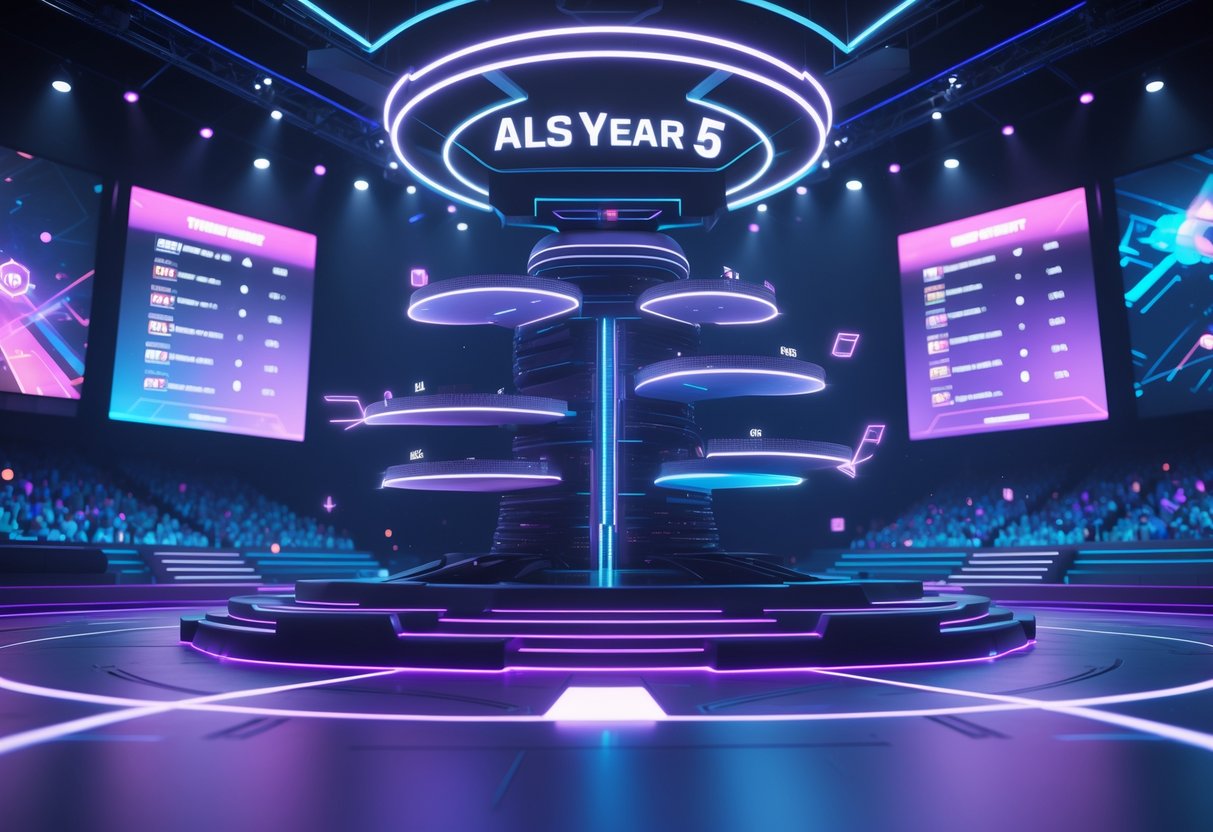
ALGS Year 5 shakes things up with some bold format changes. Now, 160 teams will battle it out at the largest LAN in Apex Legends history.
The season brings in several tournament tiers, a fresh championship points system, and three major LAN events. One of them, the ALGS Open in New Orleans, looks especially wild.
Tournament Tiers Explained
The ALGS Year 5 structure splits competition into several tiers. At the base, you’ll find the Challenger Circuit—this is where up-and-coming teams grind for a shot at bigger things.
The Pro League stands at the top. There, 120 teams from four regions—The Americas, EMEA, APAC North, and APAC South—compete for automatic spots at major events like the ALGS Open.
Preseason Qualifiers bridge the gap between tiers. Teams fight here for Pro League slots or to qualify for LANs. These qualifiers send 40 extra teams to the major tournaments.
Here’s how those spots break down by region:
- The Americas: 16 teams
- EMEA: 8 teams
- APAC North: 8 teams
- APAC South: 8 teams
Overview of Championship Points
Championship points decide team rankings all season long in ALGS Year 5. Teams rack up points based on how they do in Pro League splits and at LAN events.
The system rewards both steady performance and big tournament runs. Pro League results actually set seeding for huge events like the ALGS Open’s double-elimination bracket.
Points also impact how many teams each region gets to send to the next stage. If a region does well, it gets more slots at things like the Midseason Playoffs, where five extra teams can qualify.
EA built the points system to focus on year-round consistency, not just one lucky tournament. That means teams have to stay sharp all season if they want to stay on top.
Season Schedule and Key Dates
ALGS Year 5 stretches over several phases in 2025. It all kicks off with Preseason Qualifiers and then rolls into Split 1.
Key dates to know:
- Split 2 Pro League Qualifier: 1-3 August 2025
- ALGS Year 5 Open: 1-4 May 2025 (New Orleans Ernest N. Morial Convention Center)
This season only has three LAN events, which is a change from before. The ALGS Open is the biggest, with 160 teams fighting for $1,000,000 USD.
Split 1 and Split 2 Pro League seasons run on either side of the major LANs. Each split sets up who qualifies and how teams are seeded for the next big tournament.
The Midseason Playoffs wrap up the calendar, and teams qualify for that based on their total performance across every event.
Major Changes for ALGS Year 5
ALGS Year 5 really shakes up the format with a gigantic 160-team LAN and dynamic legend restrictions. They’ve also cut the number of regions from six to four and brought in double-elimination brackets.
New LAN Event Formats
The ALGS Open takes over from the old Split 1 Playoffs as the first major LAN. It’ll bring 160 teams to New Orleans from 1-4 May 2025—probably the biggest battle royale event we’ve seen yet.
All 120 Pro League teams get in, plus 40 squads from Preseason Qualifiers. With a $1 million prize pool, this event is way bigger than previous openers.
The Open uses a double-elimination bracket, ending in Match Point Finals. If a team loses early, they get another shot, which should make for some wild comebacks.
Both the Midseason Playoffs and Championship now pay out to the top 30 teams instead of just 20. More teams get a piece of the pie.
All three LANs together will pay out a total of $5 million. That’s a big jump in prize money for the pros.
Introduction of Legend Bans
Year 5 introduces a dynamic Legend Ban system for all LANs and qualifiers. After every match, the most-picked Legend gets banned for the rest of the series.
This forces teams to keep switching up their strategies. Nobody can just stick with their comfort pick all the way through.
If a whole class of Legends gets banned, the longest-banned Legend from that class comes back. That way, you won’t see all support or assault Legends wiped out at once.
The ban system covers the ALGS Open, Midseason Playoffs, and Championship. Teams now have to prep with way more Legend combos than before.
One-trick strategies are basically gone with this new rule.
Region Consolidation Updates
ALGS Year 5 merges six regions down to four. North and South America now form a single “Americas” region.
The four regions are:
- Americas (both North and South America)
- EMEA (Europe, Middle East & Africa)
- APAC North (Northern Asia-Pacific)
- APAC South (Southern Asia-Pacific)
Each region fields exactly 30 teams in both Pro League splits. This should make competition more balanced everywhere.
Teams qualify through Preseason Qualifiers and Challenger Circuits in their home regions. The 30-team setup makes it easier to compare regions.
Championship Points are now tied to individual players, not organizations. If a player switches teams mid-season, their points follow them.
Regional Divisions and Consolidation

ALGS Year 5 cuts things down to four main regions worldwide. Each region brings 30 teams into Pro League, making regional battles for Championship Points more focused.
Americas Region
The Americas region now mixes North and South American teams. This change means teams from all over the continent face each other more often.
Thirty teams will fight for a $125,000 regional prize pool. The season runs from April to June, with matches streamed across lots of time zones.
Key Features:
- North and South American teams together
- Weekly Pro League action
- Regional finals decide who goes to the Championship
Teams play round-robin matches during the regular season. The best squads advance to regional playoffs for Championship Points.
EMEA Overview
The EMEA region includes Europe, the Middle East, and Africa. That’s a huge area, so you get a ton of different teams and playstyles.
EMEA also has 30 Pro League teams, all fighting for Championship Points. Historically, this region has produced some of the most successful squads internationally.
Competition Structure:
- Weekly Pro League matches
- Regional finals happen in June
- Top teams qualify for the Championship
With fewer regions, the competition inside each one gets tougher. Teams need to stay on their game all season if they want to make the Championship in Sapporo, Japan.
APAC North Details
APAC North covers East Asia, including Japan and South Korea. This region keeps growing fast in Apex Legends.
The 30-team format means established teams face fresh challengers every week. Regional consolidation has made the competition even fiercer.
Regional Highlights:
- Lots of Japanese and Korean teams
- High-level gameplay and new strategies
- Fanbase and viewership keep growing
Teams compete for the same $125,000 prize pool as other regions. The regional finals decide who gets to rep APAC North at the Championship.
APAC South Highlights
APAC South pulls in Australia, Southeast Asia, and nearby areas. This brings together a bunch of passionate gaming communities.
Some of the most loyal fans come from this region. Teams from Australia and Southeast Asia always deliver some wild matchups.
Notable Elements:
- Aussie and Southeast Asian squads
- Different playstyles and strategies
- Strong support from local communities
APAC South sticks with the 30-team Pro League format. The best teams from both splits punch their tickets to the Championship.
ALGS Year 5 Tournament Roadmap

The Year 5 schedule starts with pre-season qualifiers and then moves through two competitive splits. It all leads up to the biggest Open LAN in Apex Legends history.
Teams battle across four regions for Pro League spots and a shot at the $1 million prize at the New Orleans Open.
Pre-Season Qualifiers Timeline
Pre-season qualifiers decide which squads make it into Pro League and the ALGS Open. 40 more teams join the 120 Pro League invites through these events.
The Americas get 16 spots, while EMEA, APAC North, and APAC South each get 8.
Teams grind through several qualification rounds during this phase. How they perform here sets up their seeding for the double-elimination bracket at the Open.
Quick win: Teams that crush pre-season qualifiers get better starting spots in the main bracket.
Split 1 and Split 2
Split 1 Pro League brings in 120 teams from around the world across four regions. All of them qualify automatically for the ALGS Open in New Orleans.
Split 2 Pro League Qualifier ran from 1-3 August 2025. This event decides who advances to the second split of the year.
Each split builds up to the next LAN. Teams earn points and prize money as they fight for playoff spots.
How each region does in both splits changes how many teams qualify for the Midseason Playoffs. Five teams will move from the Open to the playoffs.
LAN Event Calendar
The ALGS Year 5 Open runs 1-4 May 2025 at the New Orleans Ernest N. Morial Convention Center. This is the biggest LAN Apex Legends has ever seen.
160 teams compete live for a $1 million prize in a double-elimination format. Every series uses Legend Bans and POI Drafting for the first time at this scale.
The event lasts four days, and the top 20 teams reach Match Point Finals on Sunday. That last day uses the single Match Point format to crown the champs.
Teams start based on how they did in pre-season and Split 1. Each series sends the top 10 teams forward, while the bottom 10 drop to elimination or go home.
Qualifiers and Challenger Circuits
The ALGS Year 5 qualification system runs through three main paths that feed teams into the Pro League and Championship. Pre-season qualifiers kick off the action, while the Pro League Qualifier and Last Chance Qualifier act as crucial gateways for advancement during the season.
Pro League Qualifier Entry
The Pro League Qualifier throws together 30 teams per region in an intense online showdown. Relegated squads meet hungry challengers, all fighting for a spot in Split 2.
Team Composition:
- 8 bottom teams from Split 1 Pro League (relegated)
- 22 top-performing teams from Split 1 Challenger Circuit
Teams battle it out in a double elimination bracket. If a team loses early, they’ve still got another shot—much more forgiving than single elimination.
Everything wraps up with a Match Point Finals. Teams need to hit a point threshold and then win a match to take the crown.
Qualification Spots:
- 8 teams per region move on to Split 2 Pro League
- Regions: Americas, EMEA, APAC North, APAC South
The Challenger Circuit feeds right into this qualifier. Circuit winners punch their ticket automatically, and the next 18 teams in Challenger Circuit Points standings fill out the field.
Pre-Season Online Qualifiers
Pre-season qualifiers kick off ALGS Year 5. Registration started on 2nd February 2025, and matches got underway on 22nd February.
Tournament Structure:
- 4 single elimination tournaments per region
- Dates: 22-24 Feb, 1-3 Mar, 8-10 Mar, 15-17 Mar 2025
- All matches take place online
Qualification Requirements:
- Player level 50 or above
- Eligible players can register at algs.ea.com
Regional Qualification Spots:
| Region | Pro League + ALGS Open | ALGS Open Only |
|---|---|---|
| Americas | 8 teams | 16 teams |
| EMEA | 8 teams | 8 teams |
| APAC North | 8 teams | 8 teams |
| APAC South | 8 teams | 8 teams |
Teams that qualify for Pro League also get automatic invites to the 160-team ALGS Open. That LAN event comes with a $1,000,000 prize pool—yeah, it’s huge.
Pre-season qualifiers stick to familiar territory. Only World’s Edge and Storm Point are in the map rotation for these events.
Last Chance Qualifier Format
The Last Chance Qualifier is exactly what it sounds like—the final shot for teams hoping to reach the Championship. This online tournament starts once Split 2 Pro League wraps up.
Participant Pool:
- 40 teams per region
- Split 2 Pro League teams that missed Championship qualification
- At least 10 teams from Split 2 Challenger Circuit
Organizers run this one with a double elimination bracket too. Teams fight through winners and losers brackets, then clash in the Match Point Finals.
Championship Qualification:
- 2 teams per region grab Championship spots
- 8 teams in total make it through this route
Split 2 Challenger Circuit hands out several of these spots. Circuit tournament winners qualify automatically, and the top 6 teams minimum by Challenger Circuit Points get in as well.
Teams who drop out of Pro League still have a shot if they show up in the Challenger Circuit. This dual path rewards teams that stay consistent through the season.
For the first time, the Last Chance Qualifier features POI Drafting. Teams pick landing zones, adding a whole new tactical layer to the matches.
Pro League Structure and Splits
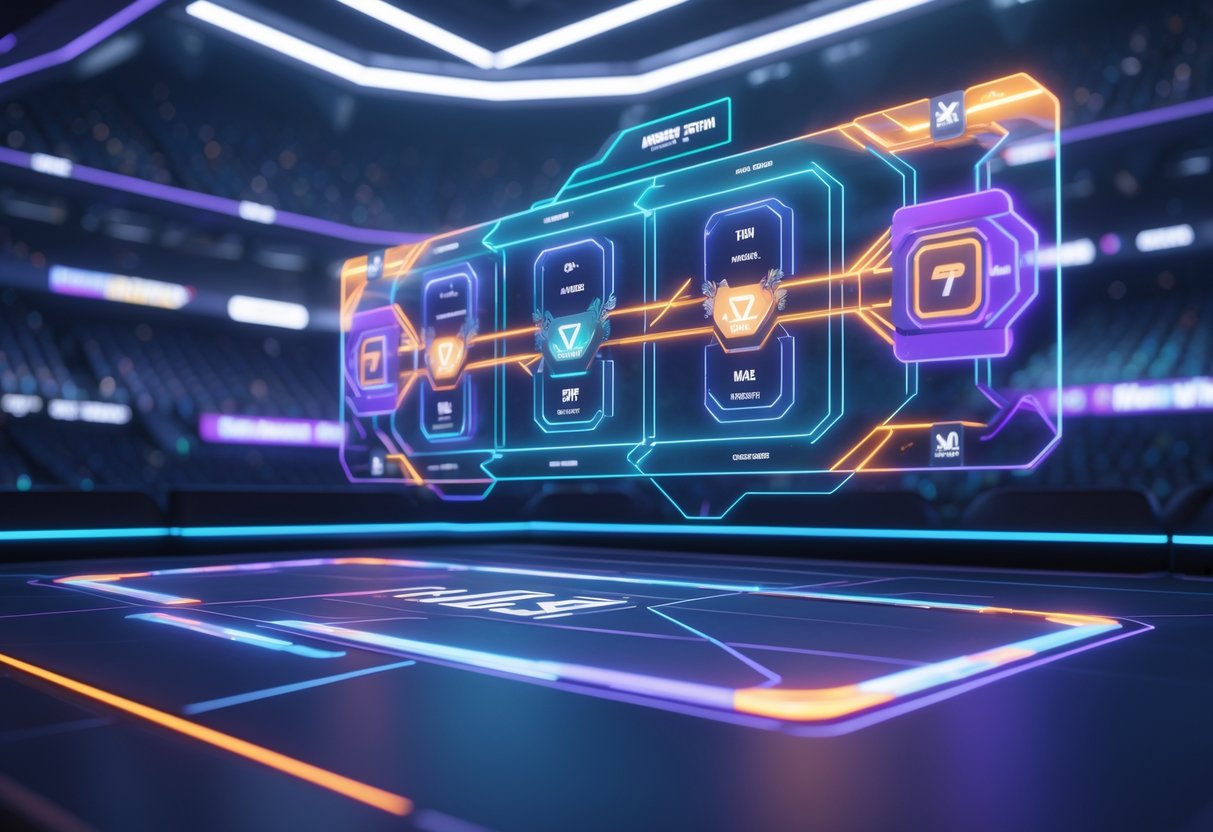
ALGS Year 5 Pro League splits into two stages, each one with 30 teams per region. They play round-robin matches for championship points and spots in regional finals.
Teams rack up points for both placement and eliminations. The top teams in each region move on to LAN playoffs.
Group Format and Scheduling
Each split runs as a closed league with 30 teams in every region. Teams go head-to-head in several rounds over a few weeks.
Organizers use a round-robin system. Every team faces every other team at least once, so everyone gets a fair shot.
Split 1 usually happens from late winter to spring. Split 2 lands later in the year.
Each match day has several games, with points given for placement and eliminations. Fans can follow their favorite teams regularly thanks to the steady schedule.
Teams that struggle risk relegation. New blood can break in through challenger circuits and qualifiers between splits.
Pro League Points Distribution
Teams pick up championship points in every match. The system rewards both survival and aggressive play.
First place gets 12 points, and the scale drops to 1 point for teams in spots 13-20. If a team finishes outside the top 20, they get nothing for placement.
Elimination points give 1 point per kill. This pushes teams to take fights instead of just hiding out.
Weekly standings decide which teams move on to regional finals. Points add up across all matches in a split.
Top teams from Split 1 get better seeds for Split 2. Still, each split keeps its own point tallies for regional finals.
Regional Finals Progression
Regional finals spots depend on region size and how tough the competition is. North America usually gets more spots, while smaller regions like South America get fewer.
The best teams from each split make it to their regional finals. These LAN events decide who qualifies for midseason playoffs and the Championship.
Split 1 winners get direct advantages for major tournaments and better seeds later on.
Teams that don’t make the cut have to wait for the next split or jump into challenger circuits. The last weeks of each split get pretty intense with so much on the line.
Regional finals bring out the best. Prize money and championship points make these matches a must-watch for fans and a big deal for the teams.
ALGS Open and LAN Events
ALGS Year 5 drops the biggest Apex Legends tournament ever—160 teams fighting for $1 million. Teams qualify automatically or through regional qualifiers, then play a double-elimination bracket until only one squad stands.
ALGS Open Qualification
Teams have two main routes into the ALGS Open. The most straightforward way? Be one of the 120 Split 1 Pro League teams—those squads get auto-invites.
These teams come from four big regions:
- The Americas (Pro League teams)
- EMEA (Pro League teams)
- APAC North (Pro League teams)
- APAC South (Pro League teams)
The last 40 spots go to teams who crush it in the Preseason Qualifiers. The Americas send 16, while EMEA, APAC North, and APAC South each get 8.
Teams get seeded in the bracket based on Split 1 Pro League results and Preseason Qualifier rankings. Higher seeds start in better positions in the double-elimination format.
Double Elimination Bracket System
The tournament runs a 160-team double elimination bracket over four days. Teams start in the main bracket; top 10 squads advance, while the bottom 10 drop to the elimination bracket.
Format features:
- Legend Bans every series
- POI Drafting for landing spots
- Four matches at once (main stage + three floor matches)
If a team falls out of the main bracket, they get a second chance in the lower bracket. Lose there, though, and they’re out.
The final 20 teams make it to Sunday’s Match Point Finals. It’s single elimination—first to hit match point and then win a game takes the title.
Prize Pool and Team Distribution
The ALGS Open dishes out a $1 million prize pool. It’s the biggest in Apex Legends history.
Besides the cash, teams earn championship points that matter for future events. How a region performs here affects how many teams they send to the Midseason Playoffs.
Other perks:
- 5 automatic Midseason Playoff spots
- Regional qualification boosts
- Better placement in the championship circuit
The tournament goes down at New Orleans Ernest N. Morial Convention Center, 1-4 May 2025. Teams play live—this is the biggest LAN event Apex Legends has ever seen.
How well a region does here can earn them extra Midseason Playoff spots. Every match really counts.
Midseason Playoffs and Championship
The Midseason Playoffs are ALGS Year 5’s big mid-year test. Teams compete for £2 million and crucial championship points that decide who makes it to the season-ending Championship.
Midseason Playoffs Format
Organizers split the Midseason Playoffs into three stages over four days. It’s a LAN event with 40 of the world’s best teams.
The action starts with Pool Play. Teams get divided into two groups of 20. Only the top 7 from each group move to finals.
Pool Play Structure:
- 2 groups of 20 teams
- Multiple matches each day
- Standard scoring system
- Top 7 per group advance
The finals use a match-point format with the last 20 teams. To win it all, a team has to reach 50 points and then snag one more match victory.
Match-point finals get wild. Teams can build big leads with placements and eliminations. Once someone hits 50, every round could end it.
Prize money splits up by where teams finish. Players on each team share the winnings equally.
Championship Qualification
Teams earn championship points at the Midseason Playoffs that really matter for Championship invites. Higher placements mean more points.
The system rewards teams for both consistency and clutch performances. If you reach the match-point finals, you pick up a big chunk of points.
Championship Point Perks:
- Direct invites
- Better seeds
- More regional spots
- Wildcard possibilities
Expect to see about 40 teams at the Championship. Midseason Playoff results play a huge role in who gets there.
Regions that perform well can lock in extra spots for the Championship. Underrepresented areas can break through with a strong showing.
Points Carry-Over
Points from the Midseason Playoffs stick with teams for the whole ALGS Year 5 season. They add up with results from other events.
The carry-over system means teams need to stay consistent. One lucky run isn’t enough for Championship qualification.
Points from big events like the Midseason Playoffs count for more than smaller tournaments. It makes sense, right? The competition is tougher and more global.
Where Points Come From:
- Midseason Playoffs placements
- Regional championships
- Global Series events
- Qualifiers
Teams keep tabs on their point totals after every tournament. The final Championship lineup combines Midseason Playoff results with a year’s worth of performance metrics.
Late tournaments are the last chance for teams to climb the leaderboard. But honestly, a strong Midseason Playoff run can set a team up for the rest of the year.
Map Pool and Tournament Maps

ALGS Year 5 uses four competitive maps: World’s Edge, Storm Point, Broken Moon, and E-District. Teams have to figure out different strategies for each map’s unique terrain and the way rotations play out.
Rotation of Tournament Maps
The map pool features World’s Edge, Storm Point, Broken Moon, and E-District. Organizers rotate these maps throughout the series.
Teams can’t just master one map and coast. The rotation forces everyone to adapt.
World’s Edge is still a classic, with its high ground and tight chokes. Storm Point brings in vertical play with its towers.
Match prep means teams have to study ring patterns and practice rotations for every scenario.
This rotation keeps things fresh for viewers and stops teams from getting too comfortable with just one map.
Introduction of Broken Moon and E-District
Broken Moon just jumped into the competitive rotation and it’s still finding its place in pro play. The map’s zip-rail system shakes up how teams rotate and move around.
Teams need to get familiar with those zip-rails fast. They open up new ways to flank or bail out of fights.
E-District is the newest map in ALGS competition. Its city layout gives teams different cover options than the usual outdoor maps.
Both maps push teams into fresh tactics. Old positioning habits from previous maps just don’t work here.
Everyone’s feeling the learning curve, even the veterans. Top teams have to rethink their strategies for these environments.
Competitive Map Strategies
Every map asks for its own approach to positioning and rotations. Storm Point really suits teams who like vertical fights and long-range battles.
On World’s Edge, grabbing the high ground early pays off. Choke points on this map often lead to third-party chaos.
Broken Moon’s zip-rails speed up rotations. Teams have to expect opponents to show up faster than before.
Urban maps like E-District mix things up with more cover. Most fights happen building-to-building instead of out in the open.
Legend picks shift with map rotation. Pathfinder shines on vertical maps, while Caustic feels right at home in tight spaces.
Most teams focus on mastering two or three maps, keeping the basics down for the rest. Honestly, trying to master all four maps in one season? That’s rough.
Legend Bans and Meta Changes
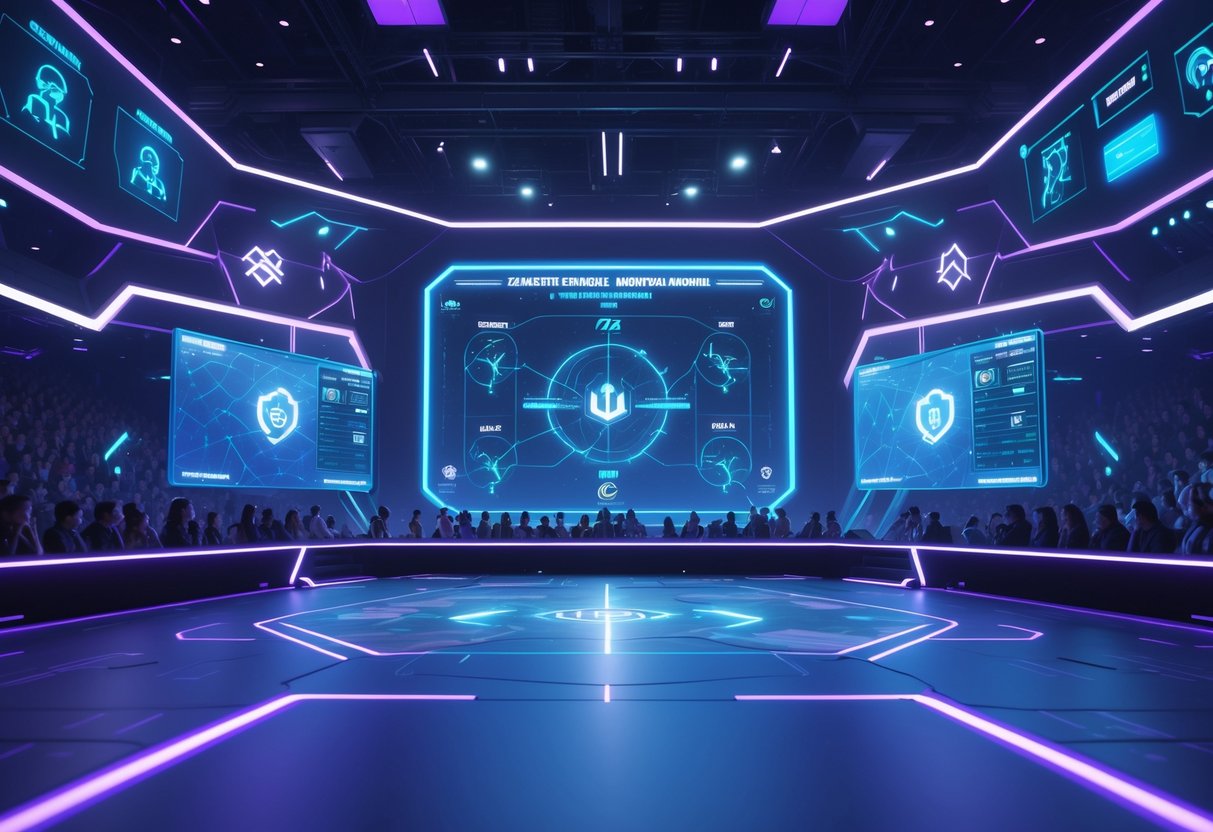
ALGS Year 5 brought in legend bans—the most-picked legend gets banned after every match. Teams now have to get good with a bunch of legends from every class if they want to keep up.
Legend Ban System Rules
The legend ban system kicks in after each match in a series. When a series starts, all legends are up for grabs.
After every match, the most-picked legend gets banned for the rest of that series. Teams end up changing their picks all the time.
Class Protection System:
- At least one legend from each class always stays available
- If every legend from a class gets banned, the one that’s been out the longest comes back
- Teams can always use every class’s abilities
This rule covers every ALGS event—Pro League, Opens, Midseason Playoffs, and qualifiers.
Teams can’t just lean on the same picks over and over. The old days of Caustic or Valkyrie being in every game are gone.
Impact on Gameplay Diversity
Legend bans totally shake up pro team strategies. We’re seeing wildly different team comps every few matches.
Teams now have to practice with multiple legends for each role. If you only played Wraith before, it’s time to branch out.
New Strategic Elements:
- Save your best legends for the matches that matter most
- Build lineups that are less likely to get banned
- Counter-pick based on what bans you expect
Lesser-used legends finally get some spotlight. Characters that barely saw play are now making appearances in tournaments.
Matches feel fresher and way more interesting to watch. Viewers get new strategies instead of the same meta over and over.
Class-Based Rotations
Class rotation rules keep teams from losing access to key abilities. Apex Legends splits legends into unique classes.
Class Categories:
- Assault: High damage
- Skirmisher: Mobility
- Recon: Info gathering
- Support: Utility
- Controller: Area denial
When bans hit a whole class, the system rotates legends back in. The legend banned the longest returns to keep things balanced.
Teams need to track which legends might rotate back in longer series. It makes planning lineups a bit trickier.
Match Point formats really benefit from this. Without rotation, teams would lose too many options during long series.
Points System and Advancement

ALGS uses a dual-point system, tracking both match performance and tournament progress through championship points. Teams have to know how kills and placements turn into points, then rack up enough championship points to move forward in the circuit.
How Championship Points Work
Championship points decide your team’s ranking during the ALGS season. You earn these points in every tournament and qualifier you play.
Match-Level Scoring Each match gives points for two things:
- Eliminations: 1 point per kill
- Placement: Points based on where you finish
| Placement | Points |
|---|---|
| 1st | 12 |
| 2nd | 9 |
| 3rd | 7 |
| 4th | 5 |
| 5th | 4 |
| 6th-7th | 3 |
| 8th-10th | 2 |
| 11th-15th | 1 |
| 16th-20th | 0 |
Tournament Days Six matches make up a match day. Your championship points add up from all your match days across the season.
Individual vs Team Points
ALGS only tracks team scores. Individual kills help your team, but you don’t get solo recognition or advancement.
Team-Based Advancement All three teammates move on together or not at all. If someone leaves mid-season, your whole roster may need to re-qualify, depending on the rules.
Shared Responsibility Winning means everyone pulls their weight. One player might rack up eliminations, but bad positioning can lose more points than you gain. Teams usually split up roles like entry fragger, support, and in-game leader to get the most points.
Roster Stability Championship points stick with the roster you registered. Swapping players mid-season often means starting over, so roster choices matter for long-term progress.
Advancing Through the Circuit
Teams climb the competitive ladder by stacking up championship points and hitting certain thresholds.
Challenger Circuit to Pro League New teams start in Challenger Circuit events. Top teams move on to Pre-Season Qualifiers, where championship points decide who gets into Pro League for the next split.
Match Point System Major tournaments use a 50-point threshold. Teams need to hit 50 championship points, then win a match to take the tournament. This stops teams from just sitting back once they’re ahead.
LAN Qualification Big LAN events are the main goal. Teams qualify by earning championship points across splits. ALGS Year 5 is bumping up to 160-team LANs, so there are more spots than ever.
Quick win: If you’re starting out, focus on consistent top-10 placements. That steady flow of points adds up faster than just chasing kills.
How to Participate and View ALGS Year 5
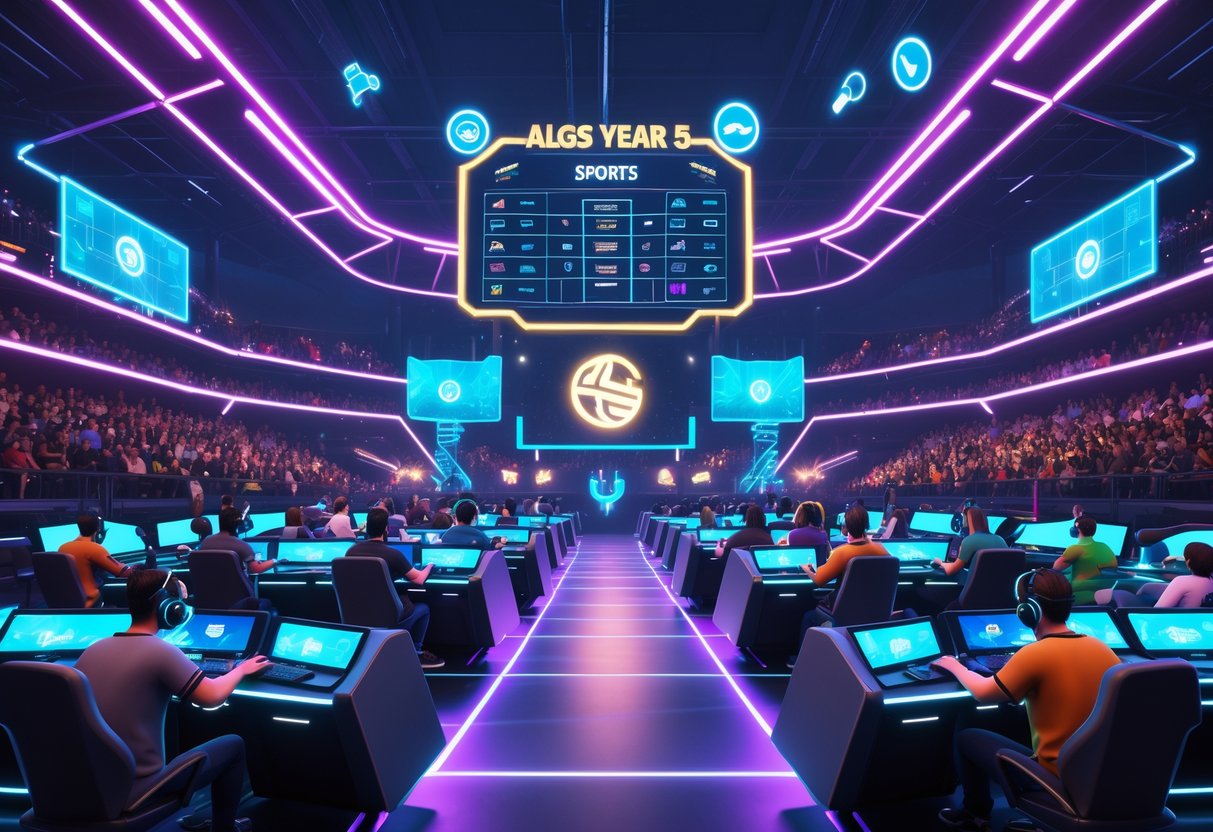
Teams can join through preseason qualifiers starting February 2025. Viewers can catch every match live on several streaming platforms. Whether you’re playing or watching, you’ll need to prep a bit differently.
Registration for Qualifiers
Battlefy, the official ALGS partner, handles registration. Teams sign up for preseason qualifiers on these weekends: February 22-24, March 1-3, March 8-10, and March 15-17, 2025.
Each region gets four single-elimination tournaments. The Americas region has 16 qualifying spots, EMEA gets 8, and both APAC North and APAC South have 8 each.
Key Registration Details:
- Platform: Battlefy’s official site
- Cost: Free
- Format: Single elimination
- Commitment: Four weekends
Teams need three registered players plus subs. Everyone plays online first, and only the best teams make it to the New Orleans LAN.
Registration usually closes 48 hours before the qualifier starts. Late signups don’t make it in, so get in early.
Eligibility Requirements
Players have to meet ALGS age and residency rules. Pro League teams (120 total) get auto-invites to the main event.
Player Requirements:
- Minimum age (usually 16-18, depends on region)
- Proof of regional residency
- EA account in good standing
- Team captain
Amateur teams fight through qualifiers for the last 40 spots. No tournament experience required, but the competition’s tough.
Pro League teams earned their spots in Split 1. These teams come from The Americas, EMEA, APAC North, and APAC South.
Warning: Double-check your region. Playing in the wrong one could get your team disqualified.
Watching Events Live
The ALGS Open runs May 1-4, 2025 at the New Orleans Ernest N. Morial Convention Center. Fans can watch matches live in a bunch of ways.
Streaming Platforms:
- Twitch (main broadcast)
- YouTube Gaming
- Official ALGS website
- Regional streams
If you want to go in person, you’ll need to buy a ticket through official channels. With 160 teams, tickets will probably go fast.
Quick win: Follow ALGS on social media for schedule updates and stream links before each tournament day.
The tournament uses a double-elimination bracket leading to Match Point Finals on Sunday. Every series includes Legend bans and POI drafts, so strategy matters more than ever.
Matches run most of the day with few breaks. If you want to see the $1 million prize ceremony, plan your viewing time.
Frequently Asked Questions
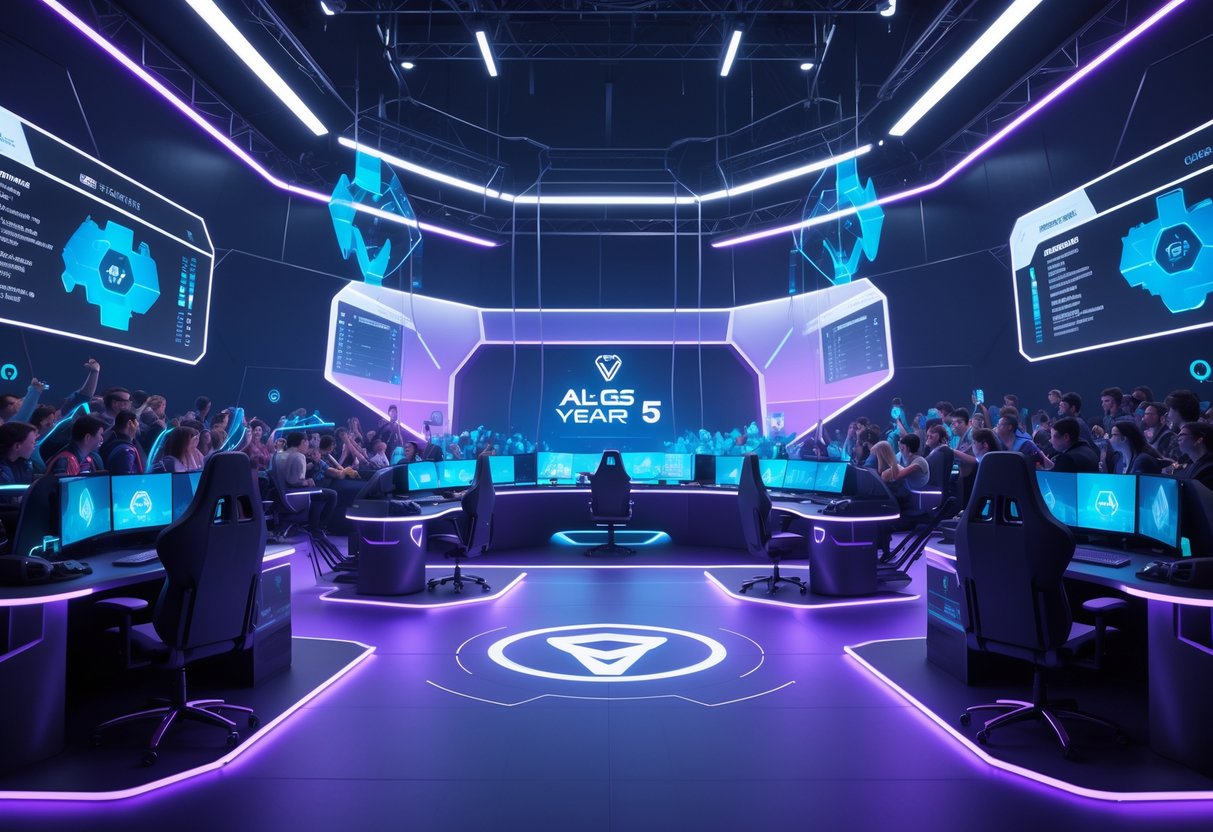
ALGS Year 5 brought big changes—from a new 160-team LAN event to legend bans. Here are answers to the most common questions about schedules, team groupings, standings, streams, and the points system.
What are the key dates and schedules for the ALGS Year 5 tournament?
The ALGS Year 5 Split 2 Pro League Qualifier happened August 1-3, 2025. The ALGS Open is set for May 1-4, 2025 in New Orleans.
This will be the biggest LAN event Apex Legends has ever had, with 160 teams chasing a $1 million prize.
The season features two Pro League splits. Each split uses a triple round-robin, so teams play 36 games.
How are the teams grouped for the ALGS Year 5 competition?
ALGS Year 5 split regions into four: Americas, EMEA, APAC North, and APAC South.
Each region has 30 teams in Pro League splits. Teams split into three groups of 10 for round-robin play.
The ALGS Open brings in 160 teams—120 from Pro League and 40 from Preseason Qualifiers.
Where can I find the current standings for the ALGS Year 5?
Check the official ALGS website for up-to-date Pro League Split 2 standings. You’ll find team performance and Pro League Points on their homepage.
Teams earn Pro League Points each split. These points help with Regular Season Standings and qualification.
Championship Points now tie to individual players, not teams. That’s a pretty big shift from past years.
Which platforms are airing the ALGS Year 5 matches live?
There’s no official list yet for ALGS Year 5 streams, but major events usually air on Twitch and YouTube.
Best bet? Check the Apex Legends Global Series website for confirmed streaming partners. They announce broadcast info before each event.
Regional streams are often available, so fans from all over can follow their teams.
How does the point system work in ALGS Year 5?
Championship Points now go to players, not teams—a big change from before.
Players earn these points in three main tournaments: Pro League splits, ALGS Open, and Midseason Playoffs.
Those points decide who qualifies for the ALGS Championship. Top-performing players from all events make it to the finals.
Are there any changes to the format for Year 5 compared to the previous year?
ALGS Year 5 shakes things up with some pretty major format changes. For two years, they stuck with the same structure, but now they’re bringing in the huge 160-team ALGS Open LAN event.
They’ve also added a dynamic Legend Ban system at every LAN event. After each match, the most-picked Legend just gets banned for the rest of that series—which should make things interesting.
Prize distribution looks a lot better now. The Midseason Playoffs and Championship will reward the top 30 teams instead of just the top 20.
The competitive map pool’s bigger too. Teams can now prep for four maps: World’s Edge, Storm Point, Broken Moon, and E-District. That’s a lot more variety for strategy, honestly.


